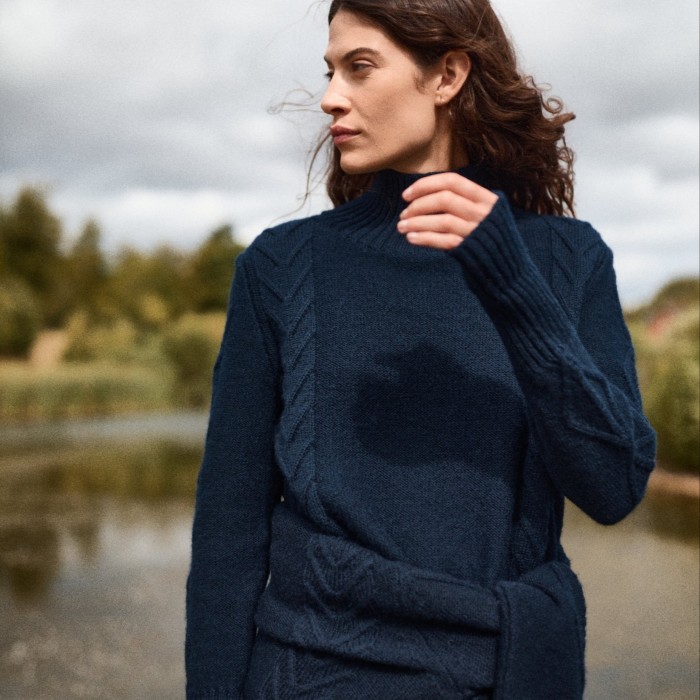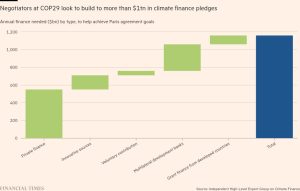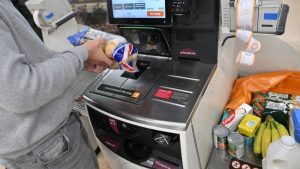Navygrey puts the Brit back into knits

Do you know your Cheviots from your Mashams? Your Bluefaced Leicesters from your Shetlands? Possibly not. And it’s likely that only the keenest sheep-spotter would be able to distinguish between the qualities of their respective fleeces. In Britain, a nation built on the wool trade, with over 60 different breeds of sheep giving us the most diverse wool clip in the world, most of us remain out of touch with our native woollies.
Rachel Carvell-Spedding, who founded women’s knitwear brand, Navygrey in 2019 is attempting to change that. In addition to developing a reputation for considered, design-led knits and sweatshirts, she has spent the past three years travelling between Aberdeenshire, the Fair Isle, Shetland, west Wales and Yorkshire, visiting sheep farmers and wool experts and experimenting with yarns from local fleeces. Her ongoing mission? To create a beautifully designed, luxurious, 100 per cent Brit-knit. This month, the brand launches two collections, both made, she says, “from wool from sheep on the British Isles; washed, spun and knitted on the British Isles”.
Carvell-Spedding’s goal is to help return market value to a high quality product, which through globalisation has become underused and undervalued. Despite confusing Made in Britain labelling, it really is rare to find knitwear manufactured with British wool. Like most knitwear brands, Navygrey also uses imported lamb’s wool and merino. While a great deal of wool is spun in Britain and Europe, most of it comes from Australian sheep and other big wool-producing nations, such as South Africa and New Zealand. “British wool was always prized, we were famous for it,” says Carvell-Spedding. “But the market was decimated between the 1960s and ’80s. It couldn’t compete on price and the influx of synthetics. Yet, what we’ve got here is still really good and it’s a resource that’s available every year. We need to use it.”


In her bright, sweater-stacked studio in south-west London, Carvell-Spedding grabs handfuls of fleecy samples from glass jars and gives an enthusiastic rundown of the “80s’ crimpy perm” quality of a Bluefaced Leicester and the “springy” joy of a Cheviot. “Bluefaced Leicester is the softest. It’s the crème de la crème of British wool and there’s not much of it around,” she says. “Cheviot is one of the brightest natural whites we have in Britain. It has a coarser, springier quality, which is why it’s often used in bedding. Masham is a cross-breed sheep and the wool is known for its resilience, lustre and substance.”
Working with these three wools, Carvell-Spedding has landed on unique blends that challenge the idea that British wool is coarse and uncomfortable. She’s created Cheviot and Masham, two capsules of warm, hard-wearing and stylish knitwear, launching this autumn. First up, the Cheviot collection, made from a bespoke blend of 30 per cent Cheviot and 70 per cent Bluefaced Leicester, sourced exclusively from farms in the UK.
In a uniform navy blue of different gauges, the designs which include two cardigans, two crew necks, a funnel neck sweater and a vest or waistcoat that she calls “the working-from-home gilet” are unfussy, elevated by detail — diamond and cable stitching, elongated sleeve ribs, a just-so drop shoulder. (From my own experience I know that Navygrey’s knit can sometimes be confused with The Row.) “We believe this is the first time this combination of wool has been used in knitwear this way,” says Carvell-Spedding. Masham, five pieces dropping a few weeks later, is a blend of 75 per cent Bluefaced Leicester and 25 per cent Masham, in undyed shades of oat and a darker umber.
Trying on the Masham chunky crew, what is immediately striking isn’t just its chic, oversized fit and landscape tones, but its substantial weight. This is the kind of knit that will stave off the central heating for hours, if not days and weeks. “A lot of customers who have tried it have said it’s different to a softer wool, but gosh, it feels like wearing a proper jumper,” says Carvell-Spedding. “The level of warmth is like coming back to what I grew up with. That idea that for environmental reasons and cost, you don’t put the heating on, you put on a jumper. We’ve kind of lost that way of thinking and we’ve forgotten what a real jumper should feel like.”


Since the 1970s and the influx of cheap cashmere, we’ve become accustomed to soft-feel knits. “We know that people are used to that almost soapy cashmere and cashmere-blend feel,” says Carvell-Spedding. “These will not feel like that but they are knits that have been designed to wear over a layer, rather than next to the skin.”
The local wool collection ranges from £250 for the Cheviot vest to £325 for a Masham detailed V-neck, Cheviot collared cardigan or funnel. “We base that on the amount of wool that’s gone into a piece. The heavier it is, the more time it’s taken to knit,” she says. “Some of our pieces use almost a kilo of wool. A classic crew knit is usually around 400 grammes and on average, a sheep produces about 2.3 kilos, so we’re almost using half a sheep. But, you know, we want these pieces to have a purpose. We want them to insulate.”
Cheviot and Masham, together with a collection of authentic Shetland knits made in genuine Shetland sheep wool and spun in Yorkshire coming next month, means that this year 20 per cent of Navygrey’s collection will come from locally grown, locally made wool. It’s a doubling on last year’s offer and well on the way to Carvell-Spedding’s 35 per cent goal for the five-year-old business.
“We want to prove that this wool has value for clothing, and bring back the market by creating a beautiful product that people want to buy,” she says. “We’d like to help bring textile-making back into the parts of the country that were ruined when it was outsourced.”
Today, according to British Wool, the farmer-run organisation that grades, sells and promotes British fleeces, we produce 1.5 per cent of the wool in the world. Australia, a wool giant, accounts for 20 per cent. The 1992 government removal of the wool price guarantee drove many farmers away from the wool trade. Haldi Kranich-Wood, business development manager at British Wool, hopes that by creating 100 per cent Brit-knits, Navygrey and other like-minded brands, such as Charl Knitwear, will encourage those farmers currently keeping sheep for meat to see the worth in their fleeces. “Navygray is really a good example of how we can build that connection between the end-product and the farmer who grew that fibre and show them how beautiful that fibre is,” she says. The organisation’s shepherd’s crook logo, introduced in 1972, confirms that a product is made with 100 per cent British wool grown by British sheep farmers.
This week, Navygrey, which sells via its website, has opened a pop-up wool shop in London’s Notting Hill, so that customers can try on their knitwear and learn more about the story behind it. “I compare the situation we’re in with British textile-making to coffee. We really want to see local coffee shops on our high streets, but if we keep walking into a Pret, then the local little ones aren’t going to thrive, are they?” says Carvell-Spedding. “If you can afford to buy knitwear at this price, why not buy British?”
Sign up for Fashion Matters, your weekly newsletter with the latest stories in style. Follow @financialtimesfashion on Instagram and subscribe to our podcast Life & Art wherever you listen
#Navygrey #puts #Brit #knits






